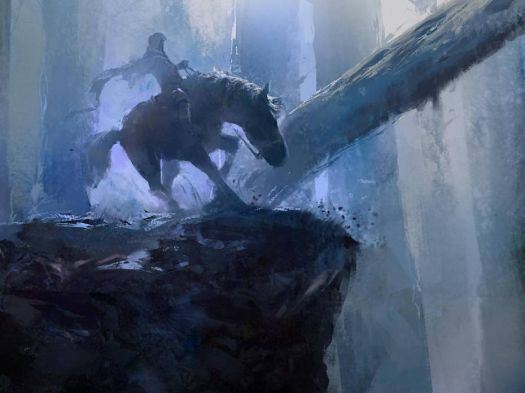Horse Jumping I (sage ability)
Horse jumping I is an authority-status sage ability that empowers the rider to navigate difficult obstacles in rough country at a much faster speed than ordinary riding. The activity is strenuous for the horse and can be dangerous for an unskilled rider, particularly if the ground ridden upon is full of free stone. Even an experienced rider can have a fall jumping over ditches and fences.
Training
Horses used for jumping must be trained to jump — this requires 6 to 8 weeks of daily activity and practice. A jumping horse must have a robustness of 14 and a courage of 16. Any trained "jumper" can easily manage any obstacle up to three feet high or three feet wide without upset. Obstacles up to 4 ft. high are possible for a heavy horse, 5 ft. for a medium horse and 6 ft. for a light horse — but jumps this high demand coordination by both the rider and the horse.
Jumping
| Height of Jump Width of Ditch |
Canter | Gallop |
|---|---|---|
| +1 ft. | 0 | -2 |
| +2 ft. | -2 | -3 |
| +3 ft. | -5 | -4 |
The table shown gives the adjustments to the horse's courage
Edit Line
In order to jump a horse, the horse must be ridden at a canter or a gallop. This is not due to the speed of the horse but due to the horse advancing one foot first as part of the horse's gait.
Limitations
Horse-jumping at an authoritative level, as Jumping-I indicates, limits the rider in two ways: the second is that not all obstacles can be jumped or even attempted, as the horse will refuse to attempt the obstacle.
If, however, the rider is upon a horse trained for jumping, then it is judged that the rider can jump an ordinary fence, either of wood or stone. That is, a fence that is no more than a hand-span wide and no more than mid-drift on an ordinary man, a maximum of about four feet. It is judged that the rider cannot perform a "bounce," which is jumping two fences that are less than 15 feet apart (three strides).
It is also judged that the rider can jump over a ditch that is up to five feet wide (1 combat hex), without a refusal from the horse, so long as the ditch does not occur in combination with a fence.
Horses will jump into and out of water that is no deeper than 18 inches without adverse risk.
Injuries
With this level of expertise, any jump can cause an injury, though the likelihood is low with most jumps and the injuries most likely to occur will not long damage the horse. When attempting to jump a fence, the character should roll a d20. On any roll except a natural 1, the horse will be fine. A 1 indicates that the horse has damaged a tendon, leading to its inflammation or strain. The horse will have suffered a 1 point injury. This roll is due to horses accumulating strain on the forelegs, leading to injuries over time.
Horses that have been injured will refuse to jump over any obstacle.
A horse can be made to jump over a ditch or fence that can be dangerous if the horse cannot see that there is a ditch on the other side or a drop of some kind (deep water, a sunken road, a falling away bank, etc.). This requires that the horse must make a dexterity check. The same is true of any situation where the horse has been made to jump something for which the rider is not prepared - remember, it is the rider's failure to prepare the horse for the jump that causes the injury. A jumping-trained horse is judged to have a dexterity of 2d4 +10.
Failure to succeed at a dexterity check will mean the horse suffers an injury of 4-14 hit points of damage and 1-6 injury points. If the hit point damage is 13-14 and the number of injury points suffered are 5-6, then the horse is made lame (though it can be cured with a restoration spell).
See Horseback Riding
